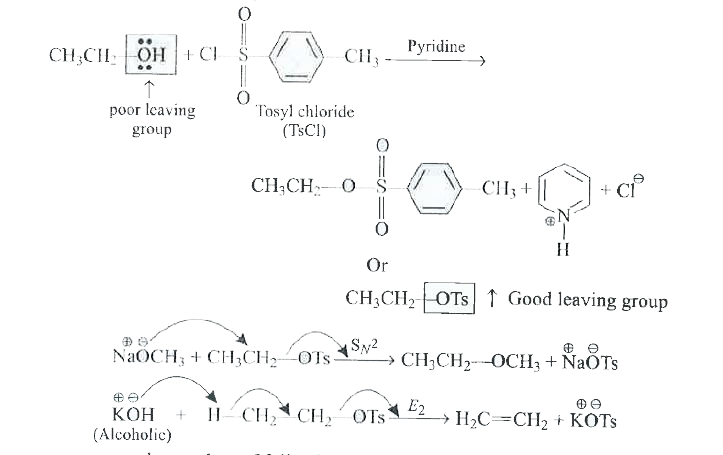Fluoride ion works as a good leaving group in aromatic nucleophilic substitution of 2,4-dinitro fluorobenzene, even though it is a poor leaving group in aliphatic SN1andSN2 mechanisms. Why?
In aromatic nucleophilic substitution when the leaving group is Cl, Br or the rate differs only by a factor of 5. This behaviour is not expected in a reaction in which Ar X bond is broken in the rate determining step: An increase in the electronegativity of the leaving group such s F causes a decrease in the electron density at the ste of attack by the nucleophile, resulting in the last reaction When the leaving gras the rate is much faster compared to other to groups. This indicates that the mechanism is different from SN1andSN2 path ways.
Similar Questions
Which of the following convert a primary hydroxyl group into good leaving group for a SN2 reaction ?
View SolutionBacause of the resonance stabilization of Arylhalides they are unreactive toward normal nuclephilic substitution reactions . However arylhalides having strong electron withdrawing groups at ortho and para positions give aromatic nucleophilic substitution reactions (SNAr mechanism ) , which involves a resonance stablilized carbanion called Meisenheimer complex

Which arylhalide is most reactive toward SNAr mechanism ?
View Solution
Knowledge Check
Alcohols are converted to tosylates by treatment with p-toluene sulfonyl chloride (TsCI) in the presence of pyridine. This overall process converts a poor leaving group (өOH) into good one (өOTs). A tosylate is a good leaving group because its conjugated acid p-toluene sulfonic acid is strong acid.
Because alkyl tosylates have good leaving groups, they undergo both nucleophilic substitution and β-elimination.

Identify the final product of following sequence of reactions :
 A
A B
B C
C D
D
Alcohols are converted to tosylates by treatment with p-toluene sulfonyl chloride (TsCI) in the presence of pyridine. This overall process converts a poor leaving group (өOH) into good one (өOTs). A tosylate is a good leaving group because its conjugated acid p-toluene sulfonic acid is strong acid.
Because alkyl tosylates have good leaving groups, they undergo both nucleophilic substitution and β-elimination.

Find the major product of following reaction :
 A
A B
B C
C D
D
Alcohols are converted to tosylates by treatment with p-toluene sulfonyl chloride (TsCI) in the presence of pyridine. This overall process converts a poor leaving group (өOH) into good one (өOTs). A tosylate is a good leaving group because its conjugated acid p-toluene sulfonic acid is strong acid.
Because alkyl tosylates have good leaving groups, they undergo both nucleophilic substitution and β-elimination.

What would be the major product of following reactions ?
 A
A B
B C
C D
D
Statement-I: Acyl halide are more reactive than acid substance amide towards nucleophilic substitution.
Because
Statement-II: X− are better leaving group than NH2.
View SolutionBacause of the resonance stabilization of Arylhalides they are unreactive toward normal nuclephilic substitution reactions . However arylhalides having strong electron withdrawing groups at ortho and para positions give aromatic nucleophilic substitution reactions (SNAr mechanism ) , which involves a resonance stablilized carbanion called Meisenheimer complex

Which of the following statement is / are true ?
View SolutionBacause of the resonance stabilization of Arylhalides they are unreactive toward normal nuclephilic substitution reactions . However arylhalides having strong electron withdrawing groups at ortho and para positions give aromatic nucleophilic substitution reactions (SNAr mechanism ) , which involves a resonance stablilized carbanion called Meisenheimer complex

What would be the product of the given reaction ?

View SolutionThe elimination reactions mainly involve three mechanism E1,E2 and E1cB. If the leaving group departs before β-proton (HΘ ion) then it is E1 mechanism. If proton is taken off first before leaving group it is E1cB mechanism.The pure E2 involves both β-Hydrogen and leaving group departing simutaneously. If acidity of β-Hydrogen increases and leaving group ability decreases then E1cB mechanism increases.

Product P is
View SolutionThe elimination reactions mainly involve three mechanism E1,E2 and E1cB. If the leaving group departs before β-proton (Ht=Θ ion) then it is E1 mechanism. If proton is taken off first before leaving group it is E1cB mechanism.The pure E2 involves both β-Hydrogen and leaving group departing simutaneously. If acidity of β-Hydrogen increases and leaving group ability decreases then E1cB mechanism increases.
Which of the following substrate will undergo fastest reaction through E1cB route
View Solution
